Mangrove Damage and Early-Stage Canopy Recovery Following Hurricane Roslyn in Marismas Nacionales, Mexico
Abstract
1. Introduction
2. Materials and Methods
2.1. Study Area
2.2. Rainfall and Wind Data
2.3. Mangrove Canopy Defoliation Time Series
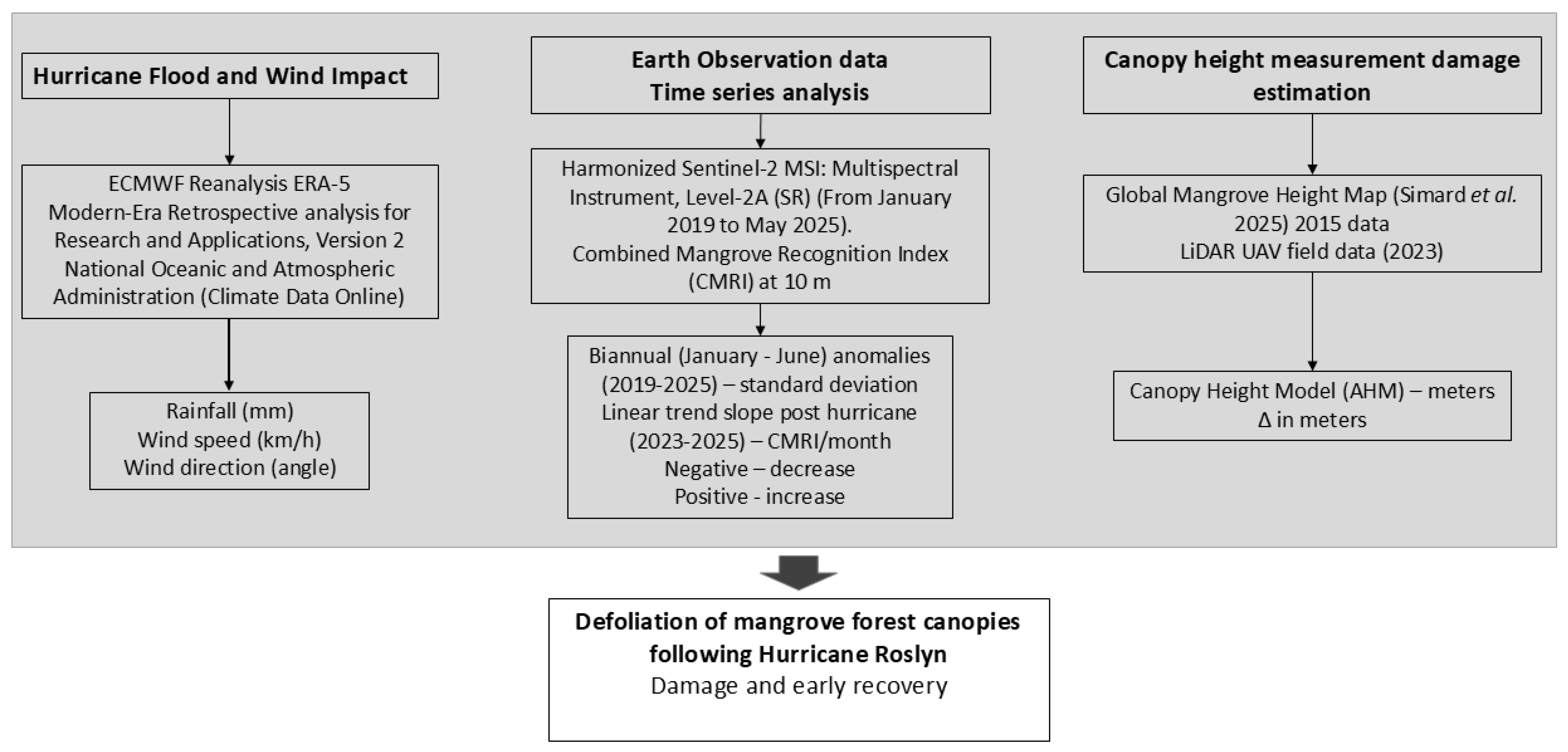
2.4. Canopy Height Models from Satellite and UAV Flight Missions
3. Results
3.1. Hurricane Flood and Wind Impact on Marismas Nacionales
3.2. Mangrove Vegetation Index Time Series
3.3. Canopy Height Models
4. Discussion
5. Conclusions
Author Contributions
Funding
Data Availability Statement
Acknowledgments
Conflicts of Interest
References
- Floriano, B.R.O.; Hanson, B.; Bewley, T.; Ishihara, J.Y.; Ferreira, H.C. A Novel Policy for Coordinating a Hurricane Monitoring System Using a Swarm of Buoyancy-Controlled Balloons Trading off Communication and Coverage. Eng. Appl. Artif. Intell. 2025, 139, 109495. [Google Scholar] [CrossRef]
- Islam, A.M.; Assal, T.J. Rapid, Landscape-Scale Assessment of Cyclonic Impacts on Mangrove Forests Using MODIS Imagery. Coasts 2023, 3, 280–293. [Google Scholar] [CrossRef]
- Robles-Archundia, D.A.; López-Vivas, J.M.; León-Cisneros, K.; Vargas-Betancourt, F.; Lara-Uc, M.M.; Hernández-Martínez, L.A.; Hernández-Stefanoni, J.L. Assessment of the Impact of Hurricane Lorena (2019) on the Mangrove Forest of Espiritu Santo Archipelago, Mexico Using Sentinel-2 Imagery. Rev. Teledetección 2025, 65, 21747. [Google Scholar] [CrossRef]
- Fanous, M.; Eden, J.M.; Remesan, R.; Daneshkhah, A. Challenges and Prospects of Climate Change Impact Assessment on Mangrove Environments through Mathematical Models. Environ. Model. Softw. 2023, 162, 105658. [Google Scholar] [CrossRef]
- Sunkur, R.; Kantamaneni, K.; Bokhoree, C.; Rathnayake, U.; Fernando, M. Mangrove Mapping and Monitoring Using Remote Sensing Techniques towards Climate Change Resilience. Sci. Rep. 2024, 14, 6949. [Google Scholar] [CrossRef] [PubMed]
- Abu Bakar, N.A.; Wan Mohd Jaafar, W.S.; Abdul Maulud, K.N.; Muhmad Kamarulzaman, A.M.; Saad, S.N.M.; Mohan, M. Monitoring Mangrove-Based Blue Carbon Ecosystems Using UAVs: A Review. Geocarto. Int. 2024, 39, 2405123. [Google Scholar] [CrossRef]
- Ferreira, A.C.; de Lacerda, L.D.; Rodrigues, J.V.M.; Bezerra, L.E.A. New Contributions to Mangrove Rehabilitation/Restoration Protocols and Practices. Wetl. Ecol. Manag. 2023, 31, 89–114. [Google Scholar] [CrossRef]
- Zhang, Y.; Li, H.; Li, D.; Hou, X.; Guo, P.; Guo, J. Evolutionary Dynamics of Island Shoreline in the Context of Climate Change: Insights from Extensive Empirical Evidence. Int. J. Digit. Earth 2024, 17, 2329816. [Google Scholar] [CrossRef]
- Fan, C.; Hou, X.; Zhang, Y.; Li, D. Satellite Data Reveal Concerns Regarding Mangrove Restoration Efforts in Southern China. Remote Sens. 2023, 15, 4151. [Google Scholar] [CrossRef]
- Makumbura, R.K.; Rathnayake, U. Variation of Leaf Area Index (LAI) under Changing Climate: Kadolkele Mangrove Forest, Sri Lanka. Adv. Meteorol. 2022, 2022, 9693303. [Google Scholar] [CrossRef]
- Hao, Q.; Song, Z.; Zhang, X.; He, D.; Guo, L.; van Zwieten, L.; Yu, C.; Wang, Y.; Wang, W.; Fang, Y.; et al. Organic Blue Carbon Sequestration in Vegetated Coastal Wetlands: Processes and Influencing Factors. Earth Sci. Rev. 2024, 255, 104853. [Google Scholar] [CrossRef]
- Kang, Y.; Kaplan, D.A.; Osland, M.J.; David Kaplan, C.A. Linking Temperature Sensitivity of Mangrove Communities, Populations and Individuals across a Tropical-Temperate Transitional Zone. J. Ecol. 2024, 112, 1256–1274. [Google Scholar] [CrossRef]
- Ramesh, M.; Swathy Krishna, P.S.; Amrutha Raj, V.; Sheela Nair, L. Coupled Coastal Monitoring Framework for the Analysis of Beach Stability and Nearshore Hydrodynamics of a Structure Influenced Medium Energy Coast in India. Ocean. Coast Manag. 2023, 239, 106619. [Google Scholar] [CrossRef]
- Lassalle, G.; Ferreira, M.P.; Cué La Rosa, L.E.; Del’Papa Moreira Scafutto, R.; de Souza Filho, C.R. Advances in Multi- and Hyperspectral Remote Sensing of Mangrove Species: A Synthesis and Study Case on Airborne and Multisource Spaceborne Imagery. ISPRS J. Photogramm. Remote Sens. 2023, 195, 298–312. [Google Scholar] [CrossRef]
- Rodríguez-Esparragón, D.; Marcello, J.; Eugenio, F.; Gamba, P. Index-Based Forest Degradation Mapping Using High and Medium Resolution Multispectral Sensors. Int. J. Digit. Earth 2024, 17, 2365981. [Google Scholar] [CrossRef]
- Paramanik, S.; Deep, N.R.; Dev Behera, M.; Kumar Bhattacharya, B.; Dash, J. Remote Sensing Letters Species-Level Classification of Mangrove Forest Using AVIRIS-NG Hyperspectral Imagery Species-Level Classification of Mangrove Forest Using AVIRIS-NG Hyperspectral Imagery. Remote. Sens. Lett. 2023, 14, 522–533. [Google Scholar] [CrossRef]
- Cavalli, R.M. Remote Data for Mapping and Monitoring Coastal Phenomena and Parameters: A Systematic Review. Remote Sens. 2024, 16, 446. [Google Scholar] [CrossRef]
- Evagorou, E.; Hasiotis, T.; Petsimeris, I.T.; Monioudi, I.N.; Andreadis, O.P.; Chatzipavlis, A.; Christofi, D.; Kountouri, J.; Stylianou, N.; Mettas, C.; et al. A Holistic High-Resolution Remote Sensing Approach for Mapping Coastal Geomorphology and Marine Habitats. Remote. Sens. 2025, 17, 1437. [Google Scholar] [CrossRef]
- Wu, Y.; Lu, C.; Wu, K.; Gao, W.; Yang, N.; Lin, J. Advancements and Trends in Mangrove Species Mapping Based on Remote Sensing: A Comprehensive Review and Knowledge Visualization. Glob. Ecol. Conserv. 2025, 57, e03408. [Google Scholar] [CrossRef]
- Ameca, E.I.; Nie, Y.; Wu, R.; Mittermeier, R.A.; Foden, W.; Wei, F. Identifying Protected Areas in Biodiversity Hotspots at Risk from Climate and Human-Induced Compound Events for Conserving Threatened Species. Sci. Total Environ. 2024, 938, 173192. [Google Scholar] [CrossRef] [PubMed]
- Valderrama-Landeros, L.; Troche-Souza, C.; Alcántara-Maya, J.A.; Velázquez-Salazar, S.; Vázquez-Balderas, B.; Villeda-Chávez, E.; Cruz-López, M.I.; Ressl, R.; Flores-Verdugo, F.; Flores-De-Santiago, F. An Assessment of Mangrove Forest in Northwestern Mexico Using the Google Earth Engine Cloud Computing Platform. PLoS ONE 2024, 19, e0315181. [Google Scholar] [CrossRef] [PubMed]
- Valderrama-Landeros, L.; Camacho-Cervantes, M.; Velázquez-Salazar, S.; Villeda-Chávez, E.; Flores-Verdugo, F.; Flores-de-Santiago, F. Detection of an Invasive Plant (Cissus verticillata) in the Largest Mangrove System on the Eastern Pacific Coast—A Remote Sensing Approach. Wetl. Ecol. Manag. 2025, 33, 13. [Google Scholar] [CrossRef]
- Berlanga-Robles, C.A. Trends in Mangrove Canopy and Cover in the Teacapan-Agua Brava Lagoon System (Marismas Nacionales) in Mexico: An Approach Using Open-Access Geospatial Data Mapping Mangrove Dynamics in Teacapan-Agua Brava. Wetlands 2025, 45, 1. [Google Scholar] [CrossRef]
- Blanco y Correa, M.; Flores-Verdugo, F.; Ortiz-Pérez, M.A.; de la Lanza-Espino, G.; López-Portillo, J.; Valdez-Hernández, I. Diagnostico Funcional de Marismas Nacionales; Universidad Autónoma de Nayarit and Secretaría de Medio Ambiente y Recursos Nautrales: Nayarit, Mexico, 2011. [Google Scholar]
- Serrano, D.; Flores-Verdugo, F.; Ramírez-Félix, E.; Kovacs, J.M.; Flores-de-Santiago, F. Modeling Tidal Hydrodynamic Changes Induced by the Opening of an Artificial Inlet within a Subtropical Mangrove Dominated Estuary. Wetl. Ecol. Manag. 2020, 28, 103–118. [Google Scholar] [CrossRef]
- Kovacs, J.M.; King, J.M.L.; Flores de Santiago, F.; Flores-Verdugo, F. Evaluating the Condition of a Mangrove Forest of the Mexican Pacific Based on an Estimated Leaf Area Index Mapping Approach. Environ. Monit. Assess. 2009, 157, 137–149. [Google Scholar] [CrossRef] [PubMed]
- Beselly, S.M.; Grueters, U.; van Der Wegen, M.; Reyns, J.; Dijkstra, J.; Roelvink, D. Modelling Mangrove-Mudflat Dynamics with a Coupled Individual-Based-Hydro-Morphodynamic Model. Environ. Model. Softw. 2023, 169, 105814. [Google Scholar] [CrossRef]
- Ochoa-Gómez, J.G.; Acosta-Velázquez, J.; Anguamea-Valenzuela, C.A.; Martinetto, P. Distribution and Structure of Conocarpus erectus L. (Combretaceae) in the Northern Limit of the Pacific Ocean (Gulf of California). Ocean Coast. Manag. 2021, 209, 105645. [Google Scholar] [CrossRef]
- Ferreira, A.C.; Freire, F.A.M.; Rodrigues, J.V.M.; Bezerra, L.E.A. Mangrove Recovery in Semiarid Coast Shows Increase of Ecological Processes from Biotic and Abiotic Drivers in Response to Hydrological Restoration. Wetlands 2022, 42, 80. [Google Scholar] [CrossRef]
- Hernández-Guzmán, R.; Ruiz-Luna, A. Combining Multisensor Images and Social Network Data to Assess the Area Flooded by a Hurricane Event. PeerJ 2024, 12, e17319. [Google Scholar] [CrossRef] [PubMed]
- Fu, B.; Zhang, S.; Li, H.; Yao, H.; Sun, W.; Jia, M.; Yang, Y.; He, H.; Li, Y. Exploring the Effects of Different Combination Ratios of Multi-Source Remote Sensing Images on Mangrove Communities Classification. Int. J. Appl. Earth Obs. Geoinf. 2024, 134, 104197. [Google Scholar] [CrossRef]
- Gorelick, N.; Hancher, M.; Dixon, M.; Ilyushchenko, S.; Thau, D.; Moore, R. Google Earth Engine: Planetary-Scale Geospatial Analysis for Everyone. Remote Sens. Environ. 2017, 202, 18–27. [Google Scholar] [CrossRef]
- Gupta, K.; Mukhopadhyay, A.; Giri, S.; Chanda, A.; Datta Majumdar, S.; Samanta, S.; Mitra, D.; Samal, R.N.; Pattnaik, A.K.; Hazra, S. An Index for Discrimination of Mangroves from Non-Mangroves Using LANDSAT 8 OLI Imagery. MethodsX 2018, 5, 1129–1139. [Google Scholar] [CrossRef] [PubMed]
- Chen, C.; Wu, W.; Fan, X.; Zhou, C.; Cui, T.; Wu, T.; Zhao, Q.; Jia, M. Linkage Analysis Between Coastline Change and Both Sides of Coastal Ecological Spaces. Water 2025, 17, 1505. [Google Scholar] [CrossRef]
- Sokal, R.R.; Rohlf, F.J. Biometry: The Principles and Practice of Statistics in Biological Research, 3rd ed.; W.H. Freeman and Co.: New York, NY, USA, 1995. [Google Scholar]
- Panuntun, I.A.; Jamaluddin, I.; Chen, Y.N.; Lai, S.N.; Fan, K.C. LinkNet-Spectral-Spatial-Temporal Transformer Based on Few-Shot Learning for Mangrove Loss Detection with Small Dataset. Remote. Sens. 2024, 16, 1078. [Google Scholar] [CrossRef]
- Simard, M.; Fatoyinbo, L.; Thomas, N.M.; Stovall, A.E.; Parra, A.; Barenblitt, A.; Bunting, P.; Hajnsek, I. New Global Mangrove Height Map with a 12 Meter Spatial Resolution. Sci. Data 2025, 12, 15. [Google Scholar] [CrossRef] [PubMed]
- Prodanov, B.; Gussev, C.; Sopotlieva, D.; Valcheva, M.; Bekova, R.; Baltakova, A.; Tzonev, R.; Popov, J. A Standard Procedure for Dune Mapping along the Bulgarian Black Sea Coast: An Integrated Approach Combining UAS Photogrammetry, Geomorphological and Phytocoenological Surveys. Front. Mar. Sci. 2025, 12, 1579724. [Google Scholar] [CrossRef]
- Price, C.A.; Papeş, M.; Sgouralis, I.; Schroeder, T.A. Surface Area to Volume Scaling of Alpha Shapes and Convex Hulls Fit to Lidar Derived Mangrove Island Point Clouds. Remote Sens. Lett. 2024, 15, 1259–1269. [Google Scholar] [CrossRef]
- Jarahizadeh, S.; Salehi, B. A Comparative Analysis of UAV Photogrammetric Software Performance for Forest 3D Modeling: A Case Study Using AgiSoft Photoscan, PIX4DMapper, and DJI Terra. Sensors 2024, 24, 286. [Google Scholar] [CrossRef] [PubMed]
- Rubio-Cisneros, N.T.; Aburto-Oropeza, O.; Jackson, J.; Ezcurra, E. Coastal Exploitation throughout Marismas Nacionales Wetlands in Northwest Mexico. Trop. Conserv. Sci. 2017, 10, 1940082917697261. [Google Scholar] [CrossRef]
- Castañeda-Moya, E.; Twilley, R.R.; Rivera-Monroy, V.H.; Zhang, K.; Davis, S.E.; Ross, M. Sediment and Nutrient Deposition Associated with Hurricane Wilma in Mangroves of the Florida Coastal Everglades. Estuaries Coasts 2010, 33, 45–58. [Google Scholar] [CrossRef]
- Liang, X.; Dai, Z.; Mei, X.; Wang, R.; Zeng, W.; Fagherazzi, S. Hurricanes Induced Irreversible Large-Scale Loss of Mangrove Forests. Geophys. Res. Lett. 2025, 52, e2025GL115692. [Google Scholar] [CrossRef]
- Lewis, J.P.; Giery, S.T.; Rossin, K.A.; Rossin, K.A.; Cissell, J.R.; Steinberg, M.K.; Sanchez, N.L.; Adams, A.J.; Layman, C.A.; Lewis, J.P.; et al. Community-Based Mangrove Restoration Following a Catastrophic Hurricane in The Bahamas. Wetl. Ecol. Manag. 2025, 33, 46. [Google Scholar] [CrossRef]
- Walcker, R.; Herteman, M.; Lambs, L. Damages Caused by Hurricane Irma in the Human-Degraded Mangroves of Saint Martin (Caribbean). Sci. Rep. 2018, 9, 18971. [Google Scholar] [CrossRef]
- Howe, J.; Merchant, S.; Hern Andez, W.J.; Pessutti, J.; Groffman, P. Assessing Mangrove Canopy Height and Health Changes in Puerto Rico Post-Hurricane Maria Using Remote-Sensing Techniques. Ecosphere 2025, 16, e70226. [Google Scholar] [CrossRef]
- Baldwin, A.; Egnotovich, M.; Ford, M.; Platt, W. Regeneration in fringe mangrove forests damaged by Hurricane Andrew. Plant Ecol. 2001, 157, 151–164. [Google Scholar] [CrossRef]
- Krauss, K.W.; Osland, M.J. Tropical Cyclones and the Organization of Mangrove Forests: A Review. Ann. Bot. 2020, 125, 213–234. [Google Scholar] [CrossRef] [PubMed]
- Hersbach, H. The ERA5 Atmospheric Reanalysis. In Proceedings of the AGU Fall Meeting Abstracts; American Geophysical Union: Washington, DC, USA, 2016; Volume 2016. [Google Scholar]
- Potisomporn, P.; Adcock, T.A.A.; Vogel, C.R. Evaluating ERA5 Reanalysis Predictions of Low Wind Speed Events around the UK. Energy Rep. 2023, 10, 4781–4790. [Google Scholar] [CrossRef]
- Langousis, A.; Mamalakis, A.; Puliga, M.; Deidda, R. Threshold Detection for the Generalized Pareto Distribution: Review of Representative Methods and Application to the NOAA NCDC Daily Rainfall Database. Water Resour. Res. 2016, 52, 2659–2681. [Google Scholar] [CrossRef]
- Shih, S.S.; Huang, Z.Z.; Hsu, Y.W. Nature-Based Solutions on Floodplain Restoration with Coupled Propagule Dispersal Simulation and Stepping-Stone Approach to Predict Mangrove Encroachment in an Estuary. Sci. Total Environ. 2022, 851, 158097. [Google Scholar] [CrossRef] [PubMed]
- Pranchai, A.; Jenke, M.; Thongmee, J.; Sutthinon, P.; Karuna, S.; Wongkamhaeng, K.; Berger, U. Artificial Macropores Enhance Mangrove Establishment in Hypersaline Environments. Restor. Ecol. 2025, 33, e70015. [Google Scholar] [CrossRef]
- Flores-de-Santiago, F.; Rodríguez-Sobreyra, R.; Álvarez-Sánchez, L.F.; Valderrama-Landeros, L.; Amezcua, F.; Flores-Verdugo, F. Understanding the Natural Expansion of White Mangrove (Laguncularia racemosa) in an Ephemeral Inlet Based on Geomorphological Analysis and Remote Sensing Data. J. Environ. Manage. 2023, 338, 117820. [Google Scholar] [CrossRef] [PubMed]
- Tysiąc, P.; Moskalewicz, D. Janowski Development of UAV-Based LiDAR and Multispectral Measurement Techniques for Monitoring Sediment Intrusion in Coastal Wetlands. Measurement 2025, 253, 117459. [Google Scholar] [CrossRef]
- Kovacs, J.M.; Liu, Y.; Zhang, C.; Flores-Verdugo, F.; de Santiago, F.F. A Field Based Statistical Approach for Validating a Remotely Sensed Mangrove Forest Classification Scheme. Wetl. Ecol. Manag. 2011, 19, 409–421. [Google Scholar] [CrossRef]
- Rivera-Trejo, F.; Radecki-Pawlik, A.; Filipczyk, J.; Priego-Hernandez, G.; Soto-Cortes, G. On Predicting of Some Consequences of Planned Dam Construction in a Pristine Sand-Gravel River Large Catchment: Rio San Pedro, Nayarit, Northwest Mexico. Ecol. Eng. 2022, 184, 106785. [Google Scholar] [CrossRef]
- Rodríguez-Sobreyra, R.; Valderrama-Landeros, L.; Flores-Verdugo, F.; Green-Ruiz, C.; Flores-de-Santiago, F. The Influence of Hydrological Variability, Geomorphology, and Salinity Determines the Allocation of Two Dominant Fringe Mangrove Species in Semiarid Coastal Systems. Discov. Conserv. 2025, 2, 10. [Google Scholar] [CrossRef]
- Wei, S.; Zhang, H.; Ling, J. A Review of Mangrove Degradation Assessment Using Remote Sensing: Advances, Challenges, and Opportunities. IScience Remote. Sens. 2025, 62, 2491920. [Google Scholar] [CrossRef]
- Minh, P.; Id, H.; Tinh, H.; Son, N.P.; Van Thuy, T.; Thi, N.; Hanh, H.; Sharma, S.; Hoai, D.T.; Duy, V.C. Mangrove Health Assessment Using Spatial Metrics and Multi-Temporal Remote Sensing Data. PLoS ONE 2022, 17, e0275928. [Google Scholar] [CrossRef]
- Doyle, T.W.; Smith, T.J.I.; Robblee, M.B. Wind Damage Effects of Hurricane Andrew on Mangrove Communities along the Southwest Coast of Florida, USA. J. Coast Res. 1995, 21, 159–168. [Google Scholar]
- Murray, M.R.; Zisman, S.A.; Furley, P.A.; Munro, D.M.; Gibson, J.; Ratter, J.; Bridgewater, S.; Minty, C.D.; Place, C.J. The Mangroves of Belize Part 1. Distribution, Composition and Classification. For. Ecol. Manage. 2003, 174, 265–279. [Google Scholar] [CrossRef]
- Rivera-Monroy, V.H.; Danielson, T.M.; Castañeda-Moya, E.; Marx, B.D.; Travieso, R.; Zhao, X.; Gaiser, E.E.; Farfan, L.M. Long-Term Demography and Stem Productivity of Everglades Mangrove Forests (Florida, USA): Resistance to Hurricane Disturbance. For. Ecol. Manage. 2019, 440, 79–91. [Google Scholar] [CrossRef]
- Vizcaya-Martínez, D.A.; Flores-de-Santiago, F.; Valderrama-Landeros, L.; Serrano, D.; Rodríguez-Sobreyra, R.; Álvarez-Sánchez, L.F.; Flores-Verdugo, F. Monitoring Detailed Mangrove Hurricane Damage and Early Recovery Using Multisource Remote Sensing Data. J. Environ. Manag. 2022, 320, 115830. [Google Scholar] [CrossRef] [PubMed]
- Peralta-Carreta, C.; Medrano-Pérez, O.R.; Alcudia-Aguilar, A.; Pham, Q.B.; Megia-Vera, H.J. Spatial Distribution of Relict Inland Mangrove (Rhizophora mangle L.) in the San Pedro River Basin: A Transboundary Analysis between Mexico and Guatemala. Estuaries Coasts 2025, 48, 59. [Google Scholar] [CrossRef]
- Cahoon, D.R.; Hensel, P.; Rybczyk, J.; McKee, K.L.; Proffitt, C.E.; Perez, B.C. Mass Tree Mortality Leads to Mangrove Peat Collapse at Bay Islands, Honduras after Hurricane Mitch. J. Ecol. 2003, 91, 1093–1105. [Google Scholar] [CrossRef]
- Yu, M.; Gao, Q. Drought, Topographic Depression, and Severe Damage Slowed Down and Differentiated Recovery of Mangrove Forests from Major Hurricane Disturbance. Remote. Sens. 2025, 17, 2223. [Google Scholar] [CrossRef]
- Xu, Y.; Qin, Y.; Li, B.; Li, J. Estimating Vegetation Aboveground Biomass in Yellow River Delta Coastal Wetlands Using Sentinel-1, Sentinel-2 and Landsat-8 Imagery. Ecol. Inform. 2025, 87, 103096. [Google Scholar] [CrossRef]
- McKee, K.L.; Cherry, J.A. Hurricane Katrina Sediment Slowed Elevation Loss in Subsiding Brackish Marshes of the Mississippi River Delta. Wetlands 2009, 29, 2–15. [Google Scholar] [CrossRef]
- Kovacs, J.M.; Wang, J.; Flores-Verdugo, F. Mapping Mangrove Leaf Area Index at the Species Level Using IKONOS and LAI-2000 Sensors for the Agua Brava Lagoon, Mexican Pacific. Estuar. Coast Shelf. Sci. 2005, 62, 377–384. [Google Scholar] [CrossRef]
- Valderrama-Landeros, L.; Flores-de-Santiago, F.; Kovacs, J.M.; Flores-Verdugo, F. An Assessment of Commonly Employed Satellite-Based Remote Sensors for Mapping Mangrove Species in Mexico Using an NDVI-Based Classification Scheme. Environ. Monit Assess 2018, 190, 23. [Google Scholar] [CrossRef] [PubMed]
- Bhatia, K.; Baker, A.; Yang, W.; Vecchi, G.; Knutson, T.; Murakami, H.; Kossin, J.; Hodges, K.; Dixon, K.; Bronselaer, B.; et al. A Potential Explanation for the Global Increase in Tropical Cyclone Rapid Intensification. Nat. Commun. 2022, 13, 6626. [Google Scholar] [CrossRef] [PubMed]
- Ozigis, M.; Ogundipe, O.; Valman, S.J.; Decker Sparks, J.L.; McCabe, H.; Yore, R.; Jackson, B. Utility of Earth Observation Data in Mapping Post-Disaster Impact: A Case of Hurricane Dorian in the Bahamas. Remote. Sens. Appl. 2025, 37, 101466. [Google Scholar] [CrossRef]
- Lovelock, C.E.; Cahoon, D.R.; Friess, D.A.; Guntenspergen, G.R.; Krauss, K.W.; Reef, R.; Rogers, K.; Saunders, M.L.; Sidik, F.; Swales, A.; et al. The Vulnerability of Indo-Pacific Mangrove Forests to Sea-Level Rise. Nature 2015, 526, 559–563. [Google Scholar] [CrossRef] [PubMed]

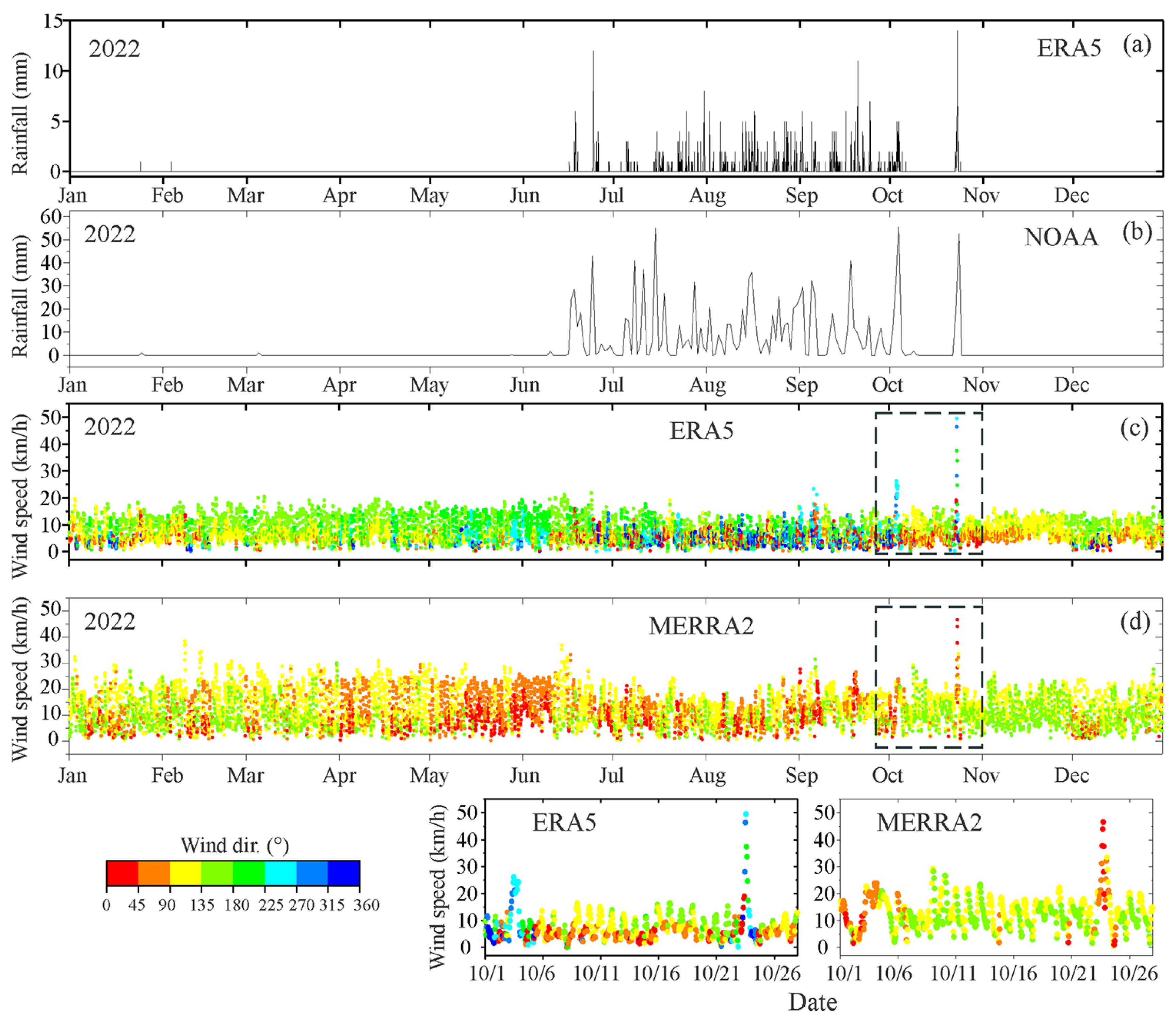
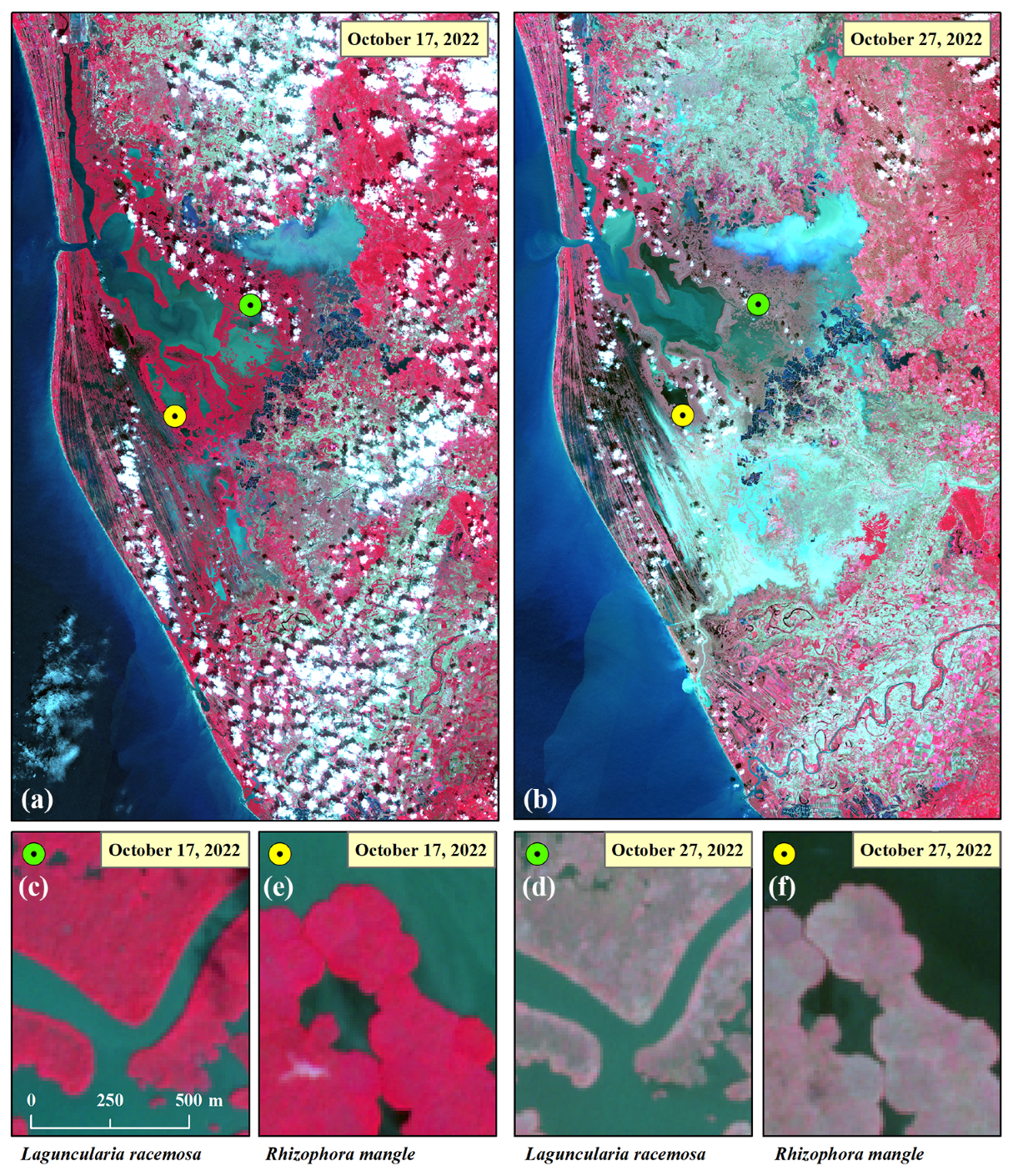
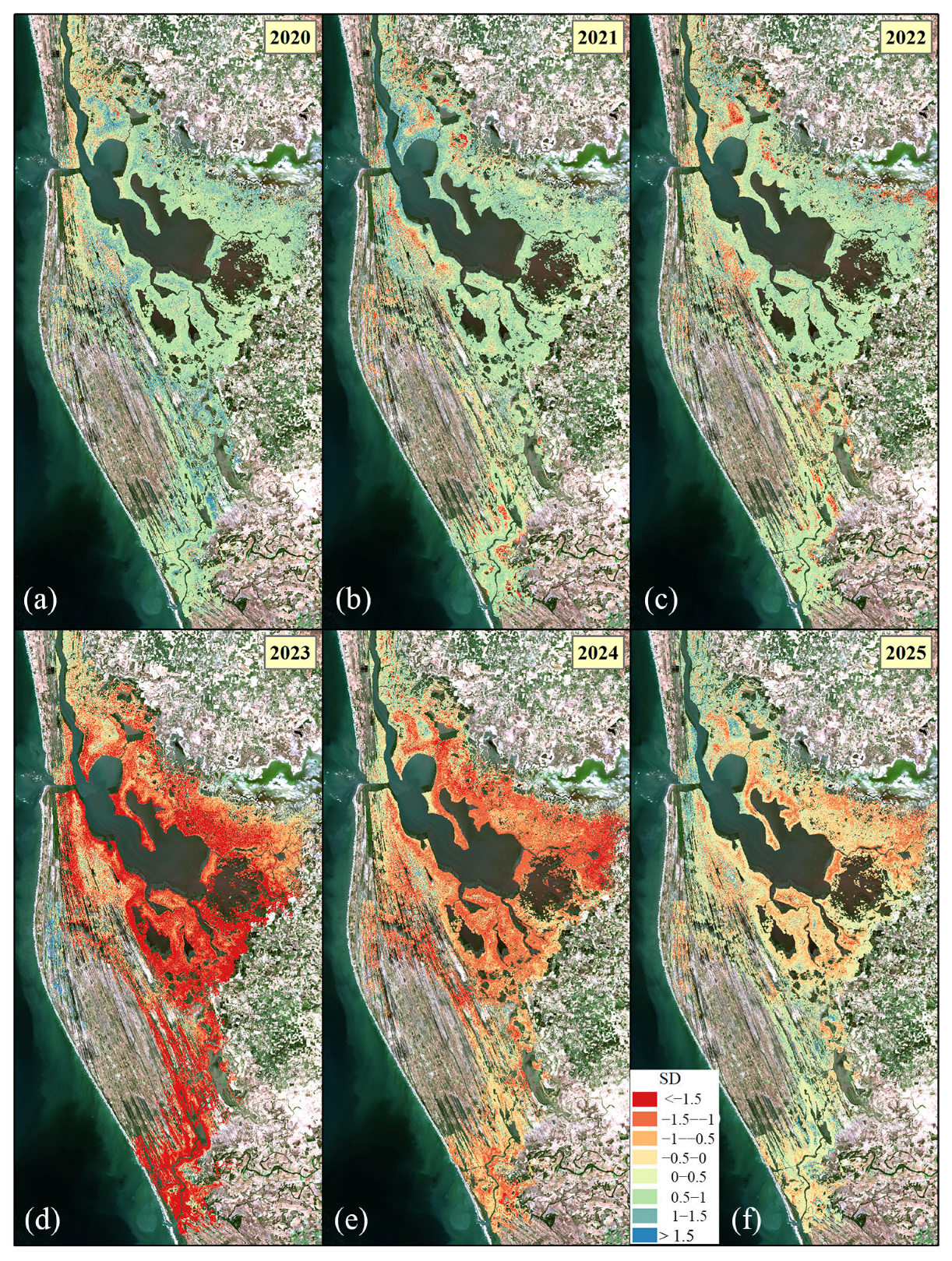
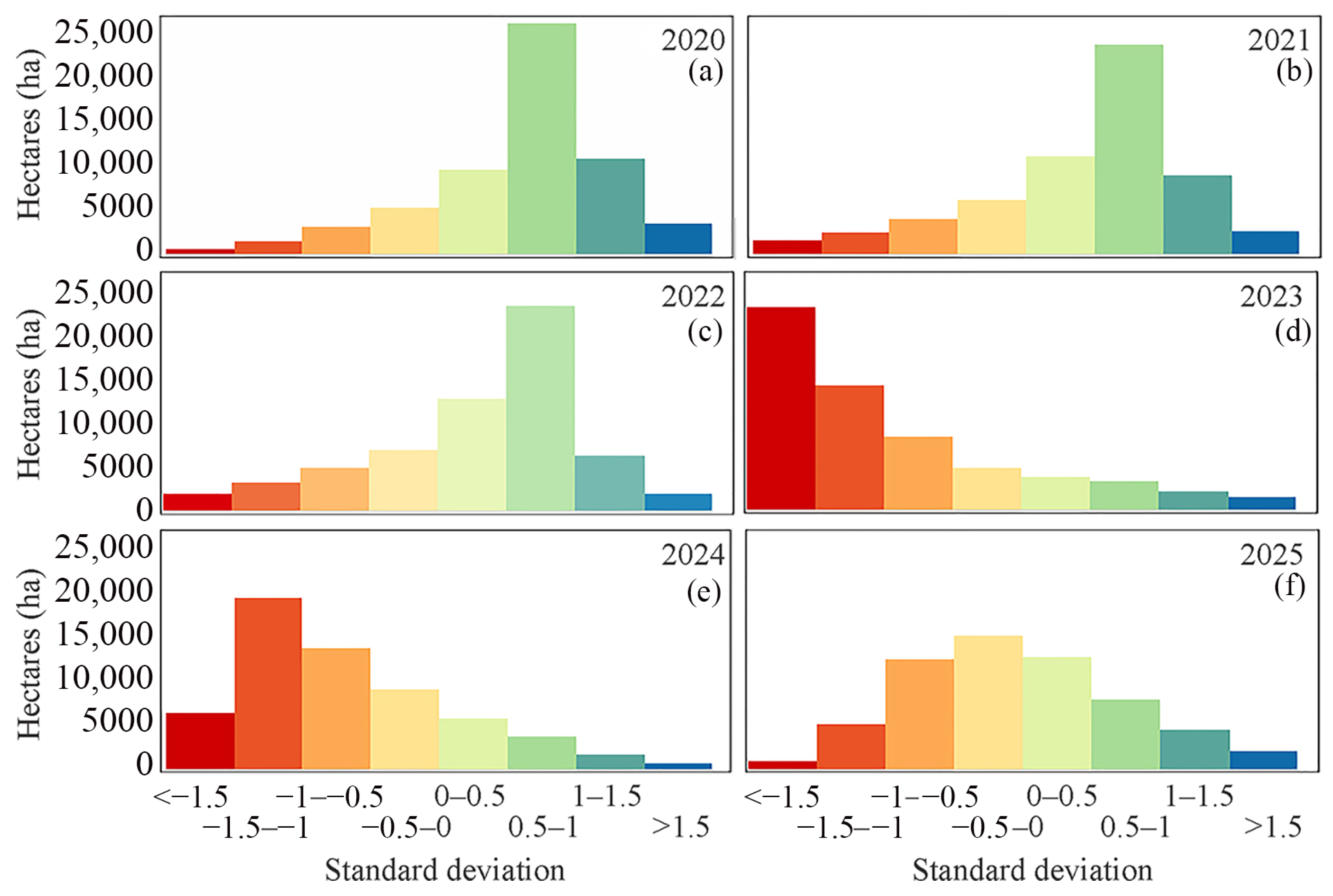
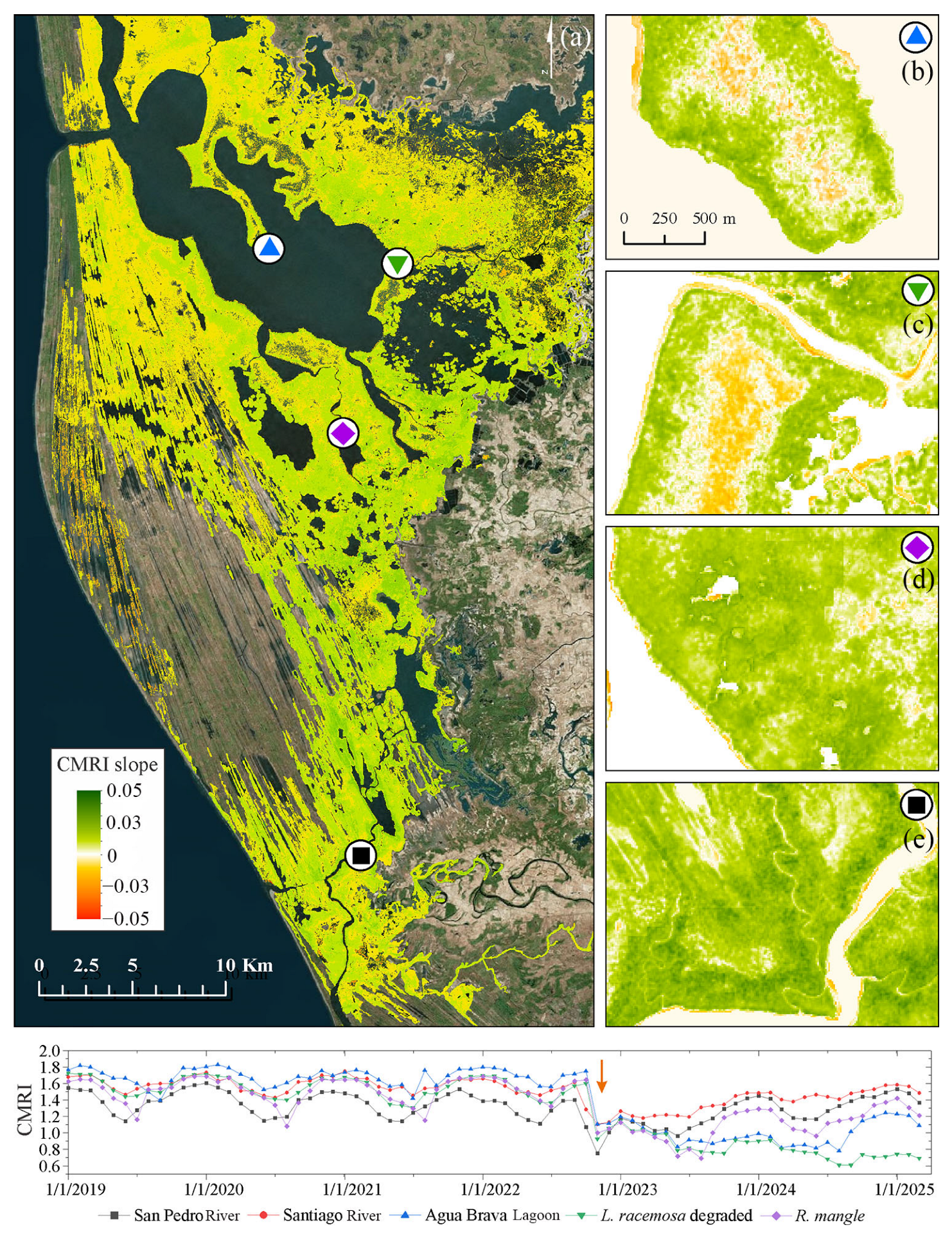

Disclaimer/Publisher’s Note: The statements, opinions and data contained in all publications are solely those of the individual author(s) and contributor(s) and not of MDPI and/or the editor(s). MDPI and/or the editor(s) disclaim responsibility for any injury to people or property resulting from any ideas, methods, instructions or products referred to in the content. |
© 2025 by the authors. Licensee MDPI, Basel, Switzerland. This article is an open access article distributed under the terms and conditions of the Creative Commons Attribution (CC BY) license (https://creativecommons.org/licenses/by/4.0/).
Share and Cite
Velázquez-Salazar, S.; Valderrama-Landeros, L.; Villeda-Chávez, E.; Cervantes-Rodríguez, C.G.; Troche-Souza, C.; Alcántara-Maya, J.A.; Vázquez-Balderas, B.; Rodríguez-Zúñiga, M.T.; Cruz-López, M.I.; Flores-de-Santiago, F. Mangrove Damage and Early-Stage Canopy Recovery Following Hurricane Roslyn in Marismas Nacionales, Mexico. Forests 2025, 16, 1207. https://doi.org/10.3390/f16081207
Velázquez-Salazar S, Valderrama-Landeros L, Villeda-Chávez E, Cervantes-Rodríguez CG, Troche-Souza C, Alcántara-Maya JA, Vázquez-Balderas B, Rodríguez-Zúñiga MT, Cruz-López MI, Flores-de-Santiago F. Mangrove Damage and Early-Stage Canopy Recovery Following Hurricane Roslyn in Marismas Nacionales, Mexico. Forests. 2025; 16(8):1207. https://doi.org/10.3390/f16081207
Chicago/Turabian StyleVelázquez-Salazar, Samuel, Luis Valderrama-Landeros, Edgar Villeda-Chávez, Cecilia G. Cervantes-Rodríguez, Carlos Troche-Souza, José A. Alcántara-Maya, Berenice Vázquez-Balderas, María T. Rodríguez-Zúñiga, María I. Cruz-López, and Francisco Flores-de-Santiago. 2025. "Mangrove Damage and Early-Stage Canopy Recovery Following Hurricane Roslyn in Marismas Nacionales, Mexico" Forests 16, no. 8: 1207. https://doi.org/10.3390/f16081207
APA StyleVelázquez-Salazar, S., Valderrama-Landeros, L., Villeda-Chávez, E., Cervantes-Rodríguez, C. G., Troche-Souza, C., Alcántara-Maya, J. A., Vázquez-Balderas, B., Rodríguez-Zúñiga, M. T., Cruz-López, M. I., & Flores-de-Santiago, F. (2025). Mangrove Damage and Early-Stage Canopy Recovery Following Hurricane Roslyn in Marismas Nacionales, Mexico. Forests, 16(8), 1207. https://doi.org/10.3390/f16081207






